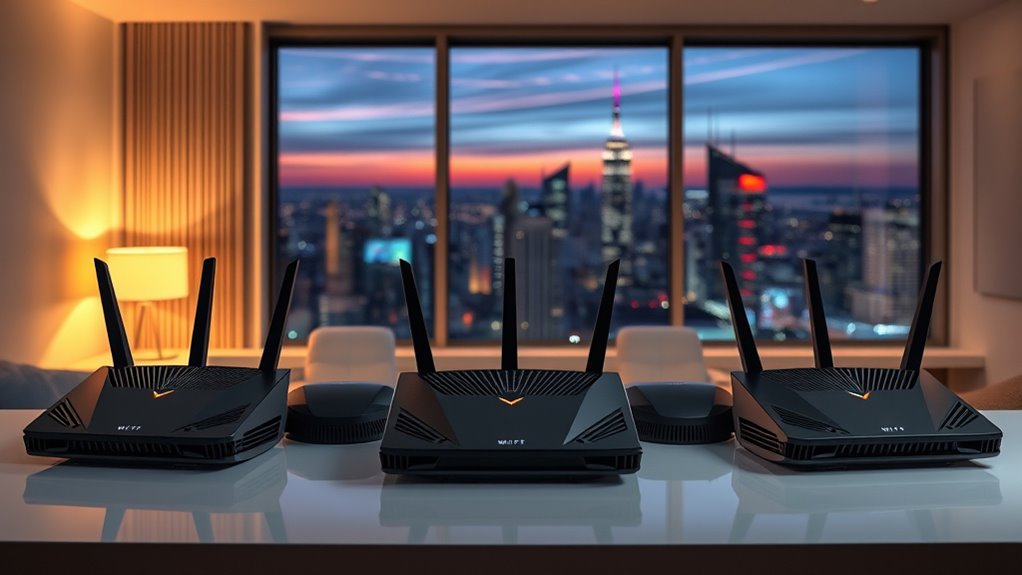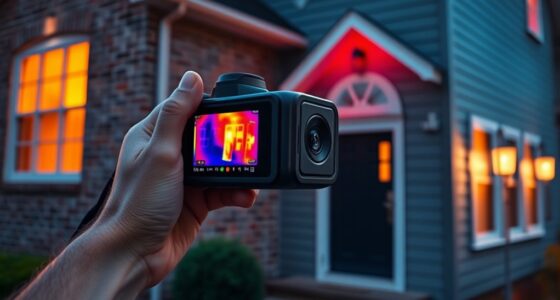If you’re looking for the best Wi-Fi 7 routers in 2025, I’ve found top options that deliver blazing speeds, extensive coverage, and advanced features like multi-gig ports and mesh support. From TP-Link’s Archer BE9700 to NETGEAR’s Nighthawk RS280S, these devices are perfect for gaming, streaming, and smart home setups. With various tri-band, dual-band, and portable models, there’s something for everyone. Keep going, and you’ll discover the ultimate router for your needs.
Key Takeaways
- Wi-Fi 7 routers offer multi-gigabit speeds up to 11.5 Gbps, ideal for demanding activities like streaming and gaming.
- They support advanced features such as MLO, OFDMA, 320 MHz channels, and 4K-QAM for optimal performance.
- High coverage mesh systems with AI-Roaming and mesh expandability ensure seamless, large-area internet.
- Multi-gigabit wired ports (2.5 Gbps, 10 Gbps) enable future-proof high-speed wired connections.
- Security features like TP-Link HomeShield and NETGEAR Armor protect your network in 2025.
TP-Link Dual-Band Wi-Fi 7 Router Archer BE230
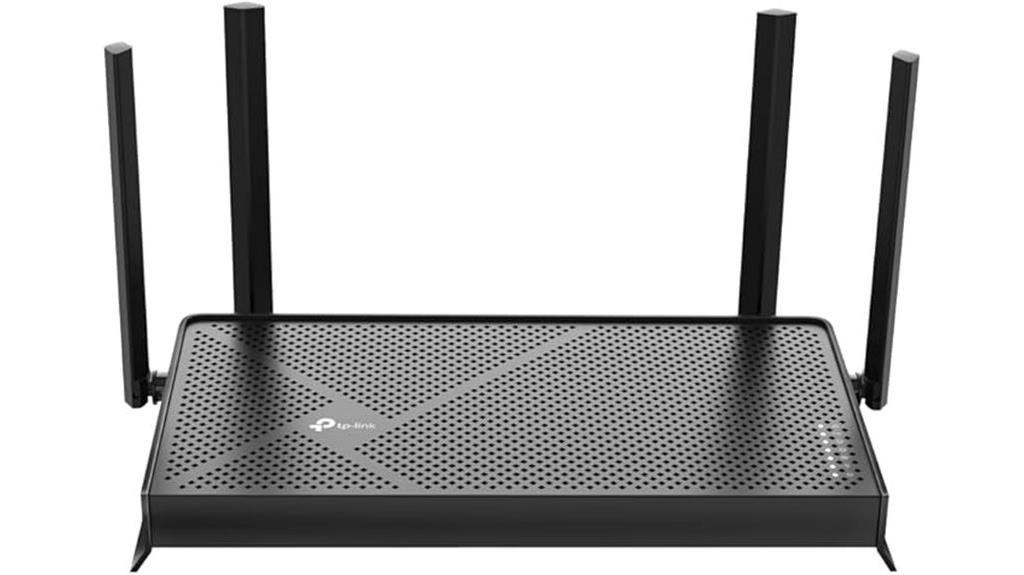
If you’re looking for a reliable Wi-Fi 7 router that can handle heavy streaming, gaming, and multiple devices simultaneously, the TP-Link Archer BE230 is an excellent choice. Powered by Wi-Fi 7, it offers faster speeds, higher data capacity, and enhanced reliability through Multi-Link Operation, Multi-RUs, and 4K-QAM. With total speeds up to 3.6 Gbps—2882 Mbps on 5 GHz and 688 Mbps on 2.4 GHz—it guarantees smooth performance for all your online activities. Its 2.0 GHz quad-core processor manages high throughput with minimal latency, making it perfect for demanding households and heavy internet use.
Best For: households and gamers needing high-speed, reliable Wi-Fi 7 connectivity to support multiple devices, streaming, and gaming simultaneously.
Pros:
- Supports Wi-Fi 7 with speeds up to 3.6 Gbps for seamless high-bandwidth activities
- Equipped with 2×2.5 Gbps ports to maximize internet and device performance
- Four external beamforming antennas provide strong, reliable coverage throughout the home
Cons:
- May be more expensive than Wi-Fi 6 or earlier models due to advanced features
- Requires compatible devices to fully utilize Wi-Fi 7 speeds and features
- Setup and management might be complex for less tech-savvy users
TP-Link Tri-Band WiFi 7 Router BE9700

The TP-Link Tri-Band WiFi 7 Router BE9700 stands out as an ideal choice for large households and power users who need reliable, high-speed connectivity across multiple devices. It supports WiFi 7 with Multi-Link Operation, channels up to 320 MHz, and speeds up to 9.7 Gbps, perfect for 4K/8K streaming, gaming, and fast downloads. Covering up to 2,600 sq. ft. and supporting 120 devices, it uses six antennas and Beamforming for strong signals. Equipped with a 10 Gbps WAN port, multiple Gbps LAN ports, and a USB 3.0, it’s future-proofed for multi-gigabit internet and smart home integration.
Best For: large households and power users seeking reliable, high-speed WiFi 7 connectivity for multiple devices and high-bandwidth activities.
Pros:
- Supports WiFi 7 with speeds up to 9.7 Gbps and channels up to 320 MHz for future-proof performance.
- Covers large areas (up to 2,600 sq. ft.) and supports up to 120 devices simultaneously with six antennas and Beamforming.
- Equipped with multi-gigabit wired ports, including a 10 Gbps WAN port and USB 3.0 for versatile connectivity and smart home integration.
Cons:
- Potential security vulnerabilities linked to manufacturing and hacking risks reported by some users.
- Requires additional cooling solutions in high-temperature environments to prevent overheating.
- Higher cost compared to older WiFi 5 routers, which might be a consideration for budget-conscious users.
TP-Link Tri-Band WiFi 7 Router (Archer BE550)
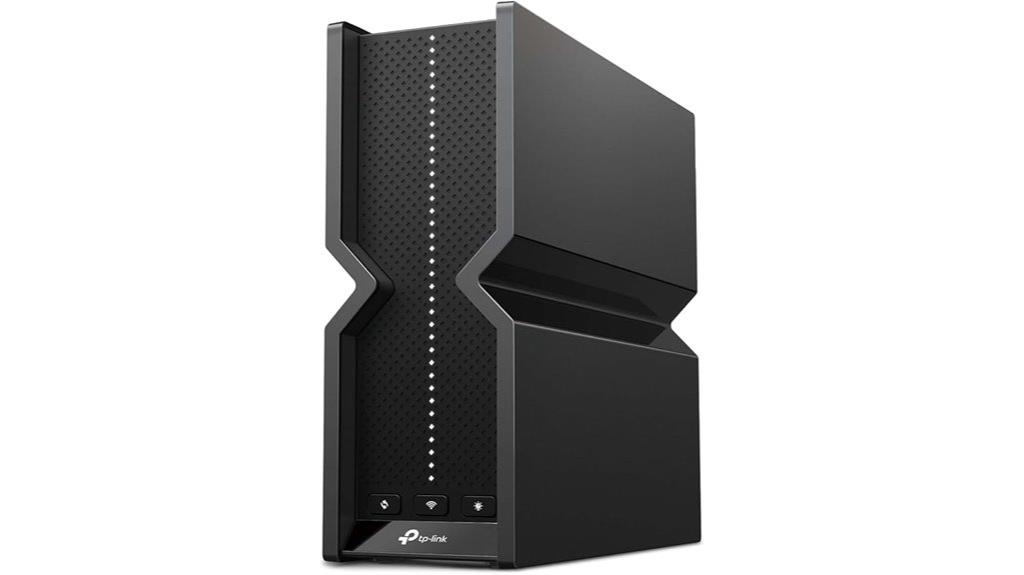
For anyone seeking a high-performance home network, the TP-Link Tri-Band WiFi 7 Router (Archer BE550) stands out with its impressive speeds and extensive coverage capabilities. It supports Wi-Fi 7 features like Multi-Link Operation, Multi-RUs, 4K-QAM, and 320 MHz channels, delivering up to 5760 Mbps on the 6 GHz band. Its support for EasyMesh allows seamless expansion with additional routers or extenders, ensuring whole-home coverage without dead zones. Equipped with a 2.5G WAN port, four 2.5G LAN ports, six antennas, and Beamforming, it guarantees fast, reliable connections. Plus, with TP-Link HomeShield, it offers robust security and network management for demanding households.
Best For: households and power users seeking ultra-fast, reliable, and scalable Wi-Fi 7 connectivity for streaming, gaming, and smart home devices.
Pros:
- Supports Wi-Fi 7 features like Multi-Link Operation and 320 MHz channels for maximum speed and efficiency
- Seamless whole-home coverage with EasyMesh compatibility and six internal antennas with Beamforming
- Equipped with a 2.5G WAN port and four 2.5G LAN ports, future-proofing the network infrastructure
Cons:
- May be more expensive than dual-band or lower-speed routers
- Setup and configuration could be complex for less tech-savvy users
- Larger size might require more space for optimal placement
Amazon eero 7 Dual-Band Mesh Wi-Fi 7 Router
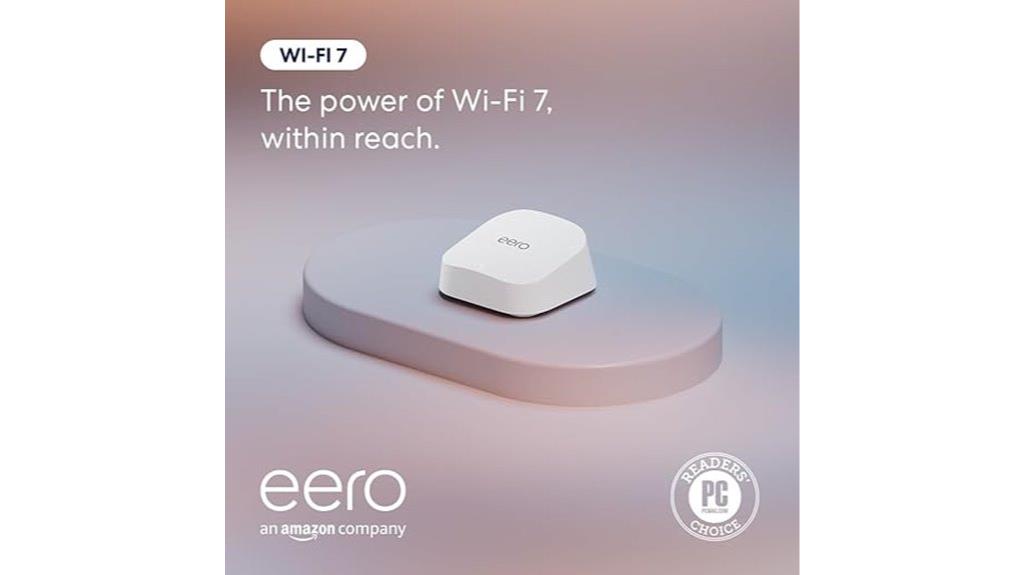
Designed for large homes and busy households, the Amazon eero 7 Dual-Band Mesh Wi-Fi 7 Router offers reliable, high-speed internet coverage with Wi-Fi 7 performance. It supports internet plans up to 2.5 Gbps and delivers wireless speeds up to 1.8 Gbps, supporting over 120 devices simultaneously. Its coverage extends up to 2,000 square feet, minimizing dead spots and ensuring fast, consistent connectivity everywhere. The router leverages advanced Wi-Fi 7 features like multi-link operation for improved performance and future-proofing. It’s easy to expand by adding additional units or replacing your current router, making it an affordable, efficient choice for large homes.
Best For: households with large homes and multiple devices seeking reliable, high-speed Wi-Fi 7 connectivity.
Pros:
- Supports internet plans up to 2.5 Gbps with wireless speeds up to 1.8 Gbps.
- Covers up to 2,000 sq. ft. and supports over 120 devices simultaneously.
- Easy to expand network coverage by adding units or replacing existing routers.
Cons:
- May be more expensive than traditional Wi-Fi 6 routers.
- Requires compatible internet plans to fully utilize high-speed capabilities.
- Advanced features like multi-link operation may be complex for non-technical users.
NETGEAR Nighthawk Tri-Band WiFi 7 Router (RS280S)
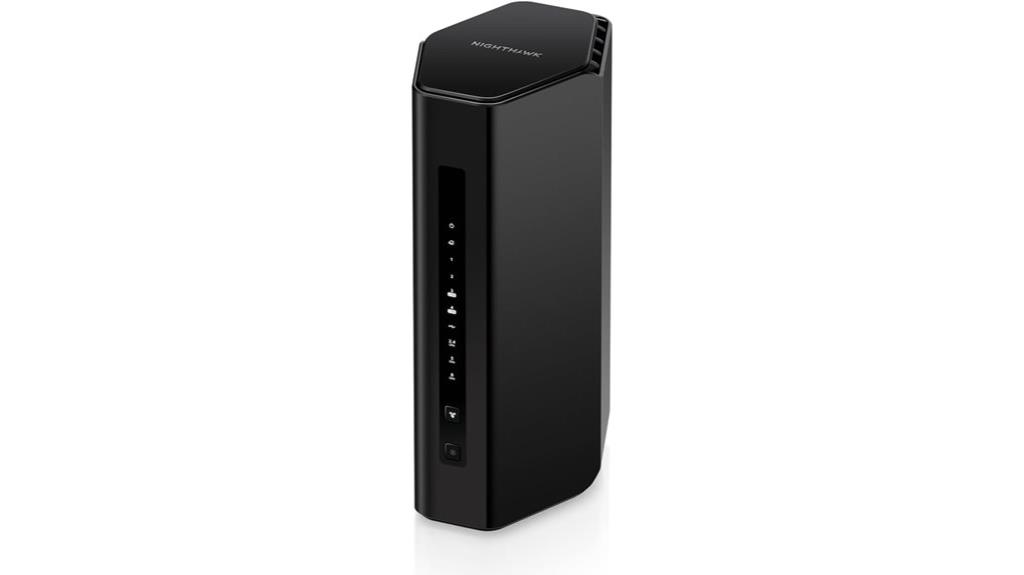
If you’re looking for a router that can handle multiple demanding devices simultaneously with lightning-fast speeds, the NETGEAR Nighthawk Tri-Band WiFi 7 Router (RS280S) is an excellent choice. It delivers speeds up to 9.2 Gbps across three bands, including an ultra-fast 6 GHz band, supporting up to 100 devices. With high-capacity channels, it’s perfect for 4K/8K streaming, gaming, and smart home setups. The router covers up to 2,500 sq. ft., offers multi-gig wired ports, and includes robust security features like NETGEAR Armor. Its straightforward setup, reliable performance, and future-proof design make it a top contender for high-speed internet in 2025.
Best For: those seeking high-speed, reliable WiFi 7 connectivity for multiple demanding devices, including gaming, streaming, and smart home systems in large homes or offices.
Pros:
- Ultra-fast tri-band WiFi 7 speeds up to 9.2 Gbps supporting extensive device connectivity
- Wide coverage of up to 2,500 sq. ft. ideal for large spaces
- Robust security features including NETGEAR Armor and automatic firmware updates
Cons:
- Higher price point compared to older or basic routers
- Some advanced features, like QoS, require additional subscriptions
- WiFi 7’s penetration through walls may be limited, affecting range in some environments
ASUS RT-BE58U WiFi 7 Extendable Router

The ASUS RT-BE58U WiFi 7 Extendable Router is an excellent choice for large households seeking fast, reliable, and expandable wireless connectivity. It supports WiFi 7 (802.11be) dual-band with speeds up to 3600 Mbps, thanks to 4096-QAM and 160MHz bandwidth. Its Multi-Link Operation ensures stable, smooth connections by linking multiple bands simultaneously. The router offers flexible WAN options, including AI WAN detection and a USB port for 4G/5G tethering, plus expandability via AiMesh. With security features like AiProtection Pro, it provides robust protection, while its user-friendly setup and ability to handle numerous devices make it ideal for big homes.
Best For: large households or users needing fast, reliable, and expandable WiFi 7 coverage with strong security features.
Pros:
- Supports WiFi 7 with speeds up to 3600 Mbps and Multi-Link Operation for stable connections
- Expandable via AiMesh with versatile WAN options including 4G/5G tethering and AI WAN detection
- Robust security with AiProtection Pro and user-friendly setup suitable for multiple devices
Cons:
- Runs warm during extended use, which may require proper placement
- Some users report weaker signals compared to other models like ASUS AC86U
- Occasional connection drops due to external ISP issues, though manageable with reboots
ASUS RT-BE92U BE9700 Tri-Band WiFi 7 Router
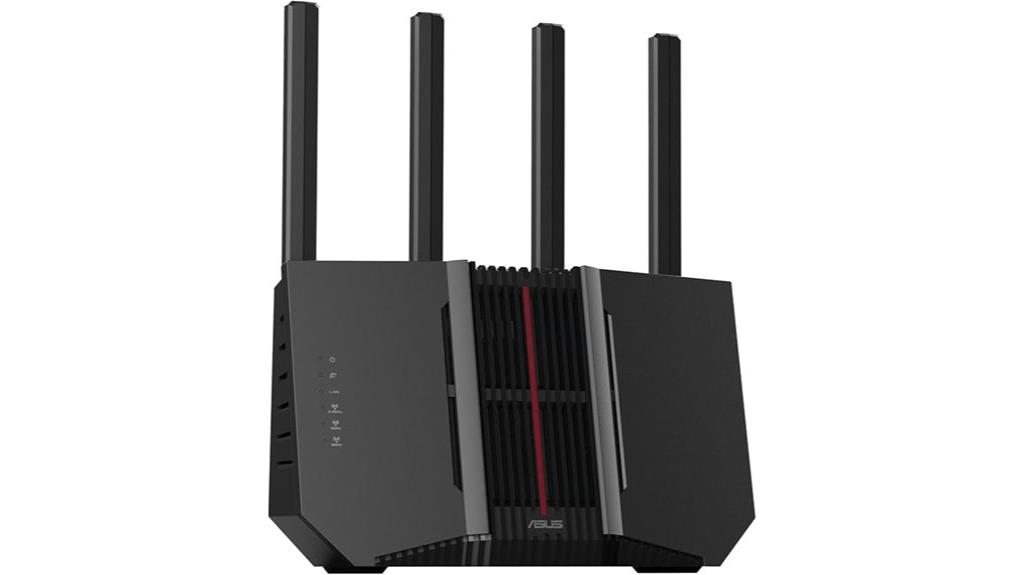
For anyone seeking a high-performance WiFi 7 router that can handle multiple devices seamlessly, the ASUS RT-BE92U BE9700 Tri-Band WiFi 7 Router stands out. It supports WiFi 7 (802.11be) with 320MHz channels in the 6 GHz band and 4096-QAM, boosting network capacity and speeds up to 9700 Mbps. Its Multi-link Operation lets me connect simultaneously across bands for stable, efficient data transfer. The tri-band setup ensures optimized performance, while flexible WAN options, including AI WAN detection and USB tethering, keep my internet reliable. Plus, built-in security features like AiProtection Pro provide subscription-free protection, making it a solid choice for fast, secure wireless connectivity.
Best For: users seeking a high-speed, reliable WiFi 7 router capable of handling multiple devices with advanced security features.
Pros:
- Supports WiFi 7 with speeds up to 9700 Mbps for ultra-fast connectivity
- Multi-link and tri-band setup for stable, efficient data transfer across devices
- Subscription-free AiProtection Pro provides comprehensive network security
Cons:
- May be more expensive than dual-band or lower-spec routers
- Complex setup could be challenging for less tech-savvy users
- Limited information on compatibility with older devices or networks
NETGEAR Orbi 370 Series Dual-Band WiFi 7 Mesh Network System
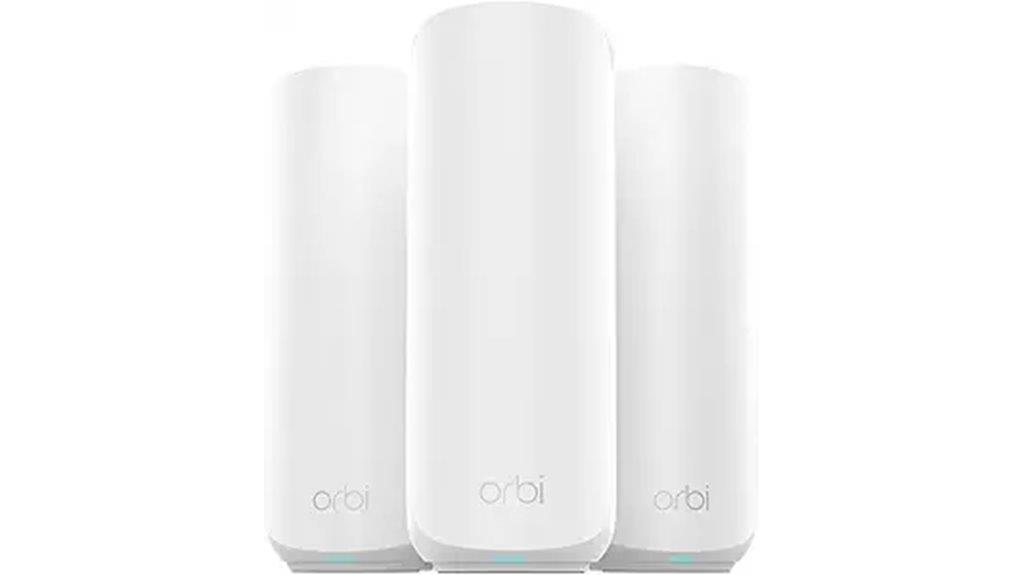
When seeking a reliable mesh network system capable of handling extensive smart home devices and high-bandwidth activities, the NETGEAR Orbi 370 Series Dual-Band WiFi 7 Mesh System stands out. It delivers speeds up to 5Gbps, supporting whole-home coverage of 6,000 sq.ft. with a router and two extenders, all compatible with any internet provider. Designed for streaming, gaming, and remote work, it supports up to 70 devices simultaneously. Easy to set up via the Orbi app, it offers reliable coverage even through thick walls. Its advanced security features and wired backhaul options make it a future-proof choice for demanding households.
Best For: households needing high-speed, reliable WiFi coverage for multiple devices, smart home integration, and demanding activities like gaming, streaming, and remote work.
Pros:
- Supports speeds up to 5Gbps with whole-home coverage of 6,000 sq.ft.
- Handles up to 70 devices simultaneously, ideal for smart homes and busy households
- Easy setup via the Orbi app with reliable, stable performance and advanced security features
Cons:
- Higher price point compared to traditional WiFi extenders and mesh systems
- Some users report receiving units with cosmetic imperfections or needing to reboot satellites for stability
- Accessories like wall mounts are sold separately, adding to overall cost
TP-Link Deco BE23 Dual-Band WiFi 7 Mesh Router
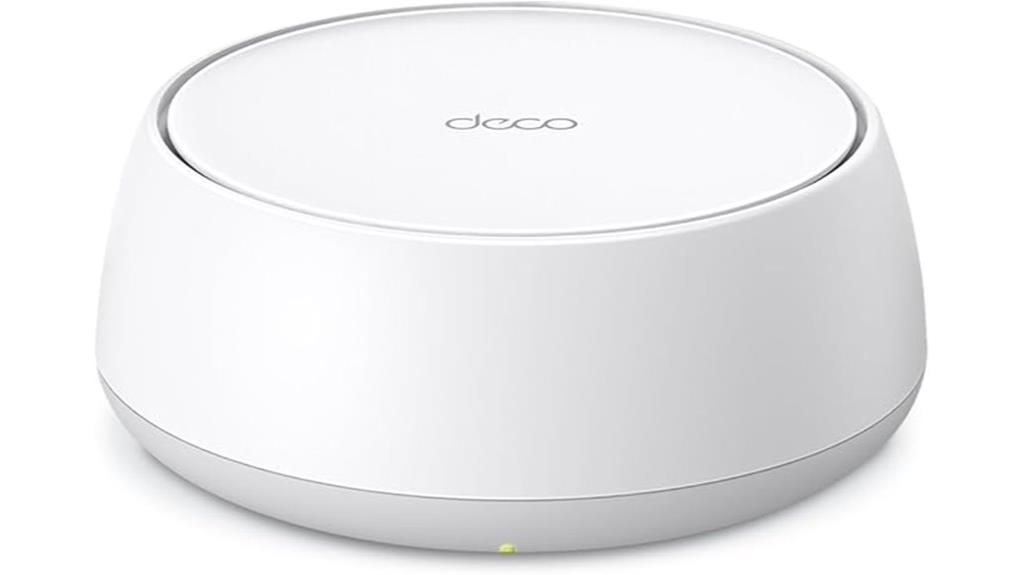
If you’re looking for a reliable mesh Wi-Fi 7 router that combines high performance with seamless coverage, the TP-Link Deco BE23 is an excellent option. It features next-gen Wi-Fi 7 with 4-stream dual-band technology, delivering speeds up to 3.6 Gbps, and supports advanced features like Multi-Link Operation (MLO) and 4K-QAM for enhanced performance. Covering up to 2,500 sq. ft, it supports over 150 devices simultaneously and offers wired connections via two 2.5 Gbps ports. Designed for security and stability, it includes intelligent AI-Roaming, robust parental controls, and easy management through the TP-Link app. Perfect for busy homes and smart tech setups.
Best For: households and smart home users seeking high-speed, reliable Wi-Fi 7 mesh coverage with advanced security features.
Pros:
- Supports top-tier Wi-Fi 7 speeds up to 3.6 Gbps and seamless multi-device connectivity
- Covers up to 2,500 sq. ft with reliable signals and supports over 150 devices simultaneously
- Features robust security, parental controls, and AI-Roaming for smooth device switching
Cons:
- Limited to a 1-pack unit, requiring additional units for larger coverage areas
- Requires compatible multi-gig modems for full gigabit internet speeds
- Advanced features may be complex for non-technical users to configure initially
NETGEAR Nighthawk WiFi 7 Router (RS180)

The NETGEAR Nighthawk WiFi 7 Router (RS180) stands out as an excellent choice for households that demand high-speed internet and reliable coverage across multiple devices. It offers WiFi 7 speeds up to 5.5 Gbps, perfect for gaming, streaming, and video calls, supporting up to 80 devices over 2,500 sq. ft. The router includes a 2.5 Gig internet port and multiple wired ports for fast, stable connections. Its sleek design and easy setup via the Nighthawk app make it user-friendly, although some users report occasional connectivity issues. Overall, it’s a high-performance device with strong security features, ideal for demanding home networks.
Best For: households that require ultra-fast WiFi speeds, extensive coverage, and strong security for multiple devices including gaming, streaming, and video conferencing.
Pros:
- Supports WiFi 7 speeds up to 5.5 Gbps for high-performance activities
- Coverage up to 2,500 sq. ft. supporting 80 devices simultaneously
- Easy setup via the Nighthawk app with built-in security features
Cons:
- Occasional connectivity issues and difficulty with network stability reported by some users
- Setup frustrations and connection failures experienced by a few users
- Some users find the device less reliable over time compared to older routers
TP-Link Tri-Band WiFi 7 Router Archer BE700

For households demanding high-speed, reliable Wi-Fi that can handle multiple devices and intensive activities, the TP-Link Tri-Band WiFi 7 Router Archer BE700 stands out. It leverages the latest Wi-Fi 7 features like Multi-Link Operation, Multi-RUs, 4K-QAM, and channels up to 320 MHz, delivering speeds up to 11,528 Mbps on the 6GHz band. It includes multi-gigabit ports, such as a 10 Gbps WAN port and 2.5 Gbps LAN port, ensuring fast data transfer. With six internal antennas and Beamforming, it offers broad coverage and strong signals. Plus, its EasyMesh support lets you extend your network seamlessly, making it perfect for demanding smart homes.
Best For: households demanding ultra-fast, reliable Wi-Fi with extensive coverage and support for multiple devices and high-bandwidth activities.
Pros:
- Utilizes the latest Wi-Fi 7 technology for maximum speeds and efficiency.
- Equipped with multi-gigabit ports, including a 10 Gbps WAN port, for rapid data transfer.
- Supports EasyMesh for seamless network expansion and improved coverage.
Cons:
- May be more expensive than standard Wi-Fi 6 routers.
- Complex setup for users unfamiliar with advanced networking features.
- Larger size could be less suitable for compact spaces.
GL.iNet Flint 3 Tri-Band WiFi 7 Router with 5x 2.5G VPN Ports
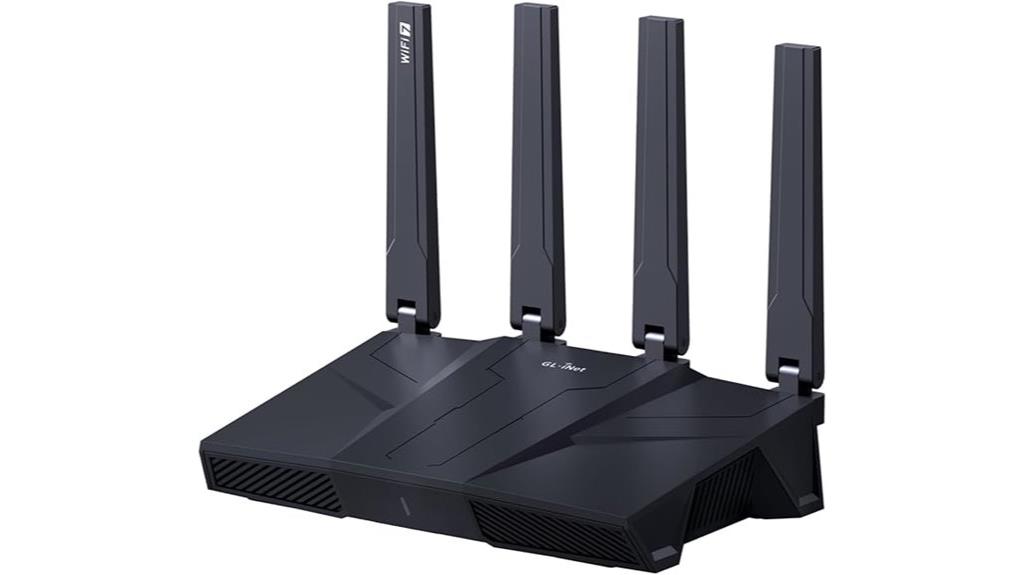
The GL.iNet Flint 3 Tri‑Band WiFi 7 Router stands out as an ideal choice for users demanding ultra-fast, reliable wired and wireless connections, especially those managing multiple devices or running demanding applications. Supporting Wi-Fi 7 speeds up to 9 Gbps with MLO, OFDMA, and 4K QAM, it offers seamless streaming, gaming, and video calls. Its tri-band setup covers up to 2,000 sq ft, while five 2.5G multi-gig ports ensure ultra-fast wired links. With high-speed VPN support, built-in ad-blocking, and extensive customization via OpenWRT, it provides both security and control. Overall, it’s perfect for large homes, offices, and privacy-conscious users seeking top-tier performance.
Best For: power users, gamers, and large households seeking ultra-fast WiFi, extensive coverage, and advanced network customization.
Pros:
- Supports Wi-Fi 7 speeds up to 9 Gbps with cutting-edge technologies like MLO and OFDMA for low latency and high performance.
- Equipped with five 2.5G multi-gig ports, delivering ultra-fast wired connections for multiple devices and demanding applications.
- Extensive customization options via OpenWRT, allowing advanced users to tailor security, VLANs, firewall, and more.
Cons:
- Diminishing 6GHz range in distant rooms may require additional extenders or mesh systems for full coverage.
- Slight warmth during operation and initial connectivity issues reported by some users, though overall stability remains high.
- Advanced setup and customization may be complex for non-technical users despite guided tutorials.
GL.iNet GL-BE3600 Portable Travel Router with Dual-Band Wi-Fi 7
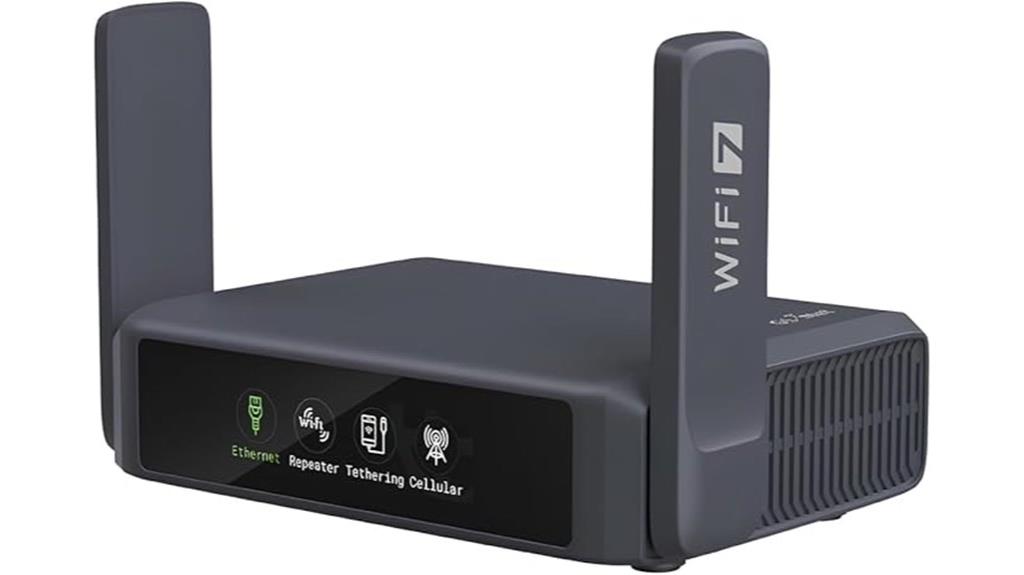
Travelers and remote workers who need reliable, high-speed internet on the go will find the GL.iNet GL-BE3600 Portable Travel Router with Dual-Band Wi-Fi 7 an excellent choice. Its compact design (just 10.6 ounces) makes it perfect for travel, with dual-band Wi-Fi offering speeds up to 688 Mbps on 2.4 GHz and 2.9 Gbps on 5 GHz. Equipped with dual 2.5G Ethernet ports, a USB 3.0 port, and multiple plug options, it handles hotel Wi-Fi, cellular, tethering, and Ethernet modes. The touchscreen simplifies setup, network management, and VPN toggling, while OpenWrt firmware provides extensive customization, security, and advanced networking features for demanding users.
Best For: remote workers, frequent travelers, and tech enthusiasts seeking reliable, high-speed internet on the go with extensive customization and security features.
Pros:
- Compact, lightweight design ideal for travel and portability
- Dual-band Wi-Fi 7 with high-speed connectivity up to 2.9 Gbps on 5 GHz
- Extensive customization options via OpenWrt firmware, including VPN, server hosting, and plugins
Cons:
- Slight learning curve for initial setup and advanced customization
- Requires quality cables for optimal wired connections
- Premium features may be more complex for casual users to fully utilize
TP-Link Tri-Band Wi-Fi 7 Gaming Router Archer GE650
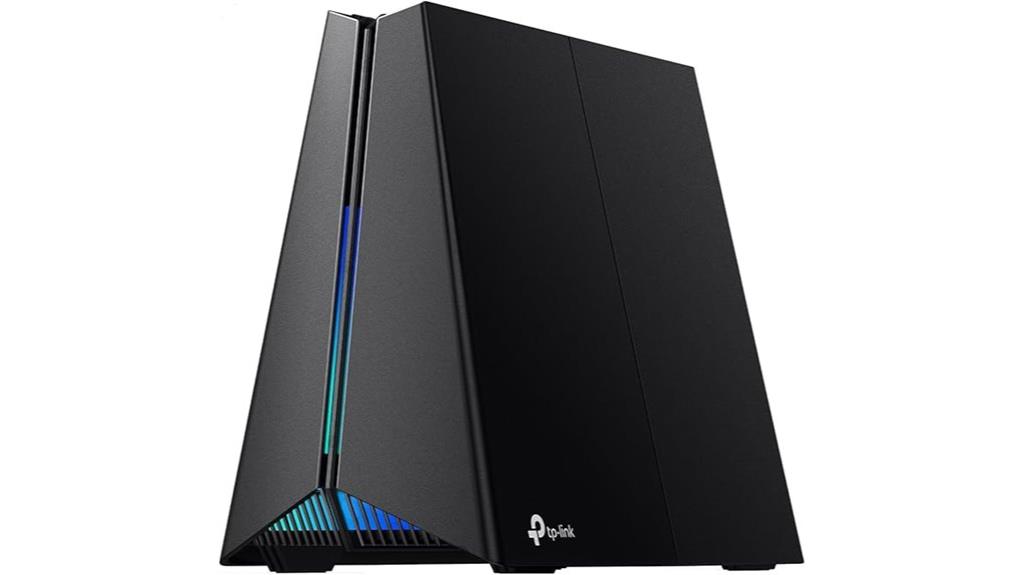
Gamers seeking lightning-fast, stable internet connections will find the TP-Link Tri-Band Wi-Fi 7 Gaming Router Archer GE650 to be an excellent choice. It supports 6 GHz, 5 GHz, and 2.4 GHz bands, reaching speeds up to 5764 Mbps on the 6 GHz band, thanks to the expanded spectrum and three 320 MHz channels. Multi-Link Operation allows all bands to work simultaneously, ensuring seamless gameplay and streaming. With multi-gig ports—including 5 Gbps and 2.5 Gbps options—it handles high-bandwidth wired connections effortlessly. Designed for gamers, it offers game traffic prioritization, network monitoring, and RGB customization, making it both powerful and visually striking.
Best For: gamers and high-demand users seeking ultra-fast, stable Wi-Fi 7 connections with advanced wired options and customizable features.
Pros:
- Supports tri-band Wi-Fi 7 with speeds up to 5764 Mbps on 6 GHz for optimal gaming and streaming
- Equipped with multi-gig ports including 5 Gbps and 2.5 Gbps options for high-bandwidth wired connections
- Features gaming optimization tools like WTFast, network monitoring, and RGB customization for enhanced gaming experience
Cons:
- Premium pricing may be a barrier for some users
- Complex setup process for users unfamiliar with advanced networking features
- Large, distinctive design may not suit all aesthetic preferences or fit into smaller spaces
TP-Link Deco BE63 Tri-Band WiFi 7 Mesh System
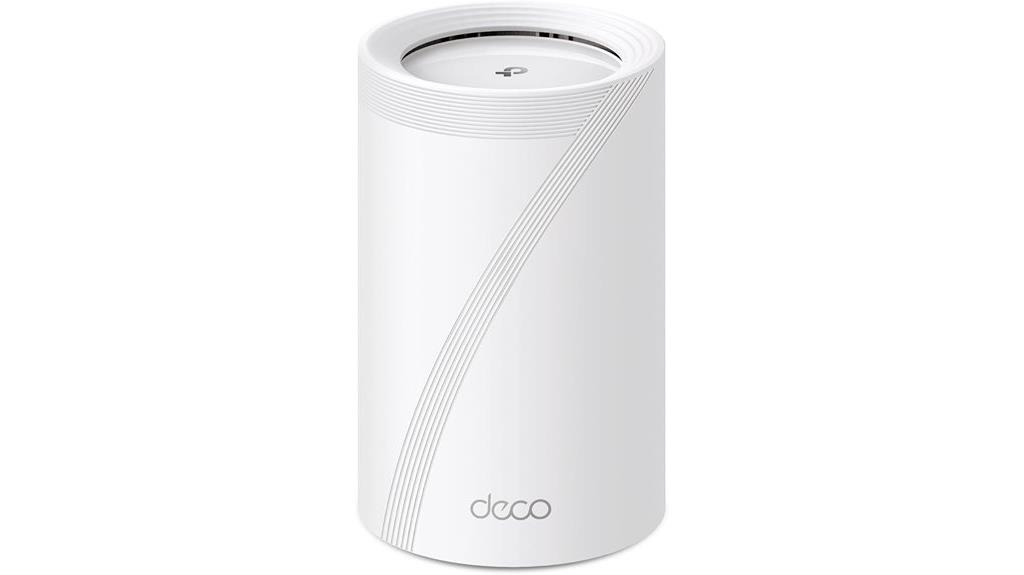
If you’re looking for a mesh system that combines ultra-fast speeds with extensive coverage and device capacity, the TP-Link Deco BE63 Tri-Band WiFi 7 Mesh System is an excellent choice. It delivers speeds up to 10 Gbps across three bands—6GHz, 5GHz, and 2.4GHz—covering up to 3,000 sq.ft. and supporting over 200 devices. With six streams, multi-gigabit ports, and a USB 3.0 connection, it’s future-proof for demanding smart homes, gaming, and streaming. Its AI-Roaming technology guarantees seamless device transitions, while TP-Link’s HomeShield secures your network. Easy to set up via the Deco app, it’s a robust, scalable solution for large, busy households.
Best For: households and smart homes requiring ultra-fast, extensive WiFi coverage with high device capacity and future-proof connectivity.
Pros:
- Supports speeds up to 10 Gbps across three bands, ideal for demanding streaming, gaming, and downloads
- Covers up to 3,000 sq.ft. and supports over 200 devices without performance issues
- Features AI-Roaming for seamless device handoff and advanced security via TP-Link’s HomeShield platform
Cons:
- Higher price point compared to WiFi 6 systems, which may be a consideration for budget-conscious users
- Some compatibility issues reported with certain smart devices, such as Generac generators
- Setup may require careful configuration when integrating with existing smart home devices or multiple networks
Factors to Consider When Choosing Wi‑Fi 7 Routers

When choosing a Wi‑Fi 7 router, I focus on key factors like speed and capacity to handle multiple devices smoothly. Coverage and range are also vital to guarantee everyone stays connected, while wired options add stability for essential devices. Additionally, security features and simple setup processes help me pick a router that’s both safe and user-friendly.
Speed and Capacity
Speed and capacity are crucial factors to contemplate when choosing a Wi-Fi 7 router because they directly impact your network’s performance and reliability. Wi-Fi 7 supports multi-link operation and channel bonding up to 320 MHz, enabling combined speeds surpassing 11 Gbps. It allows simultaneous connection to multiple bands, optimizing overall capacity and reducing congestion. Advanced features like 4K-QAM modulation significantly boost data throughput and efficiency. Additionally, multi-Gig ports—such as 2.5 Gbps and 10 Gbps—enhance wired performance, ensuring fast data transfer for demanding tasks. These improvements make it possible to stream 4K or 8K content seamlessly, download large files quickly, and enjoy high-bandwidth gaming without buffering or lag. Prioritizing speed and capacity ensures your network can handle the most intensive online activities effortlessly.
Coverage and Range
Ever wonder how far your Wi-Fi signal can reach comfortably throughout your home? With Wi-Fi 7, coverage depends on several factors. Routers equipped with multiple high-gain antennas and beamforming technology focus signals to improve range and strength across large spaces. Mesh systems with multiple nodes can extend coverage seamlessly, minimizing dead zones and ensuring consistent performance. Wi-Fi 7’s Multi-Link Operation (MLO) allows simultaneous connections across bands, boosting range and reducing latency in expansive environments. High channel bandwidths, like 320 MHz, support faster data transmission over longer distances, even in complex layouts. However, environmental factors such as walls, furniture, and interference can impact coverage. Strategic placement of your router is key to maximizing range and maintaining a strong connection throughout your home.
Wired Connectivity Options
Choosing the right Wi-Fi 7 router means paying close attention to its wired connectivity options, as these can substantially impact your network’s speed and reliability. Many models now feature multi-gig ports—2.5 Gbps, 5 Gbps, or even 10 Gbps Ethernet—that support ultra-fast wired connections, perfect for demanding tasks like gaming or large file transfers. Multiple Ethernet ports allow connecting numerous wired devices such as NAS storage, gaming consoles, or smart home hubs, ensuring stable performance. Support for wired backhaul in mesh systems helps maintain a reliable connection between nodes, reducing latency and improving overall stability. Additionally, USB ports supporting 3.0 or higher speeds enable sharing storage or printers across your network, enhancing wired device connectivity. These wired options are crucial for maximizing your network’s speed and consistency.
Security Features
Security features are a critical consideration when selecting a Wi-Fi 7 router, as they protect your network from cyber threats and unauthorized access. Modern routers come with advanced protections like WPA3 encryption, which ensures your data stays secure, and real-time IoT security to monitor connected devices. Many support integrated platforms such as TP-Link HomeShield or NETGEAR Armor, offering network monitoring, parental controls, and malware protection. Subscription-free security tools like AI-based threat detection and Safe Browsing reduce ongoing costs while enhancing safety. Built-in VPN support enables secure remote access and encrypted browsing, safeguarding your privacy. Robust security architectures often include network segmentation for IoT devices, automatic security scans, and vulnerability management, providing extensive protection for your connected home.
Ease of Setup
Setting up a Wi-Fi 7 router can be straightforward if you select a model that offers intuitive installation features. Look for routers with mobile apps or web interfaces that guide you through the process, often taking just minutes. Features like guided tutorials, QR code scanning, or step-by-step instructions make setup simple and fast. *Guarantee* the router supports automatic detection of your internet connection type—fiber, cable, or DSL—for seamless configuration. Quick setup modes or one-touch Wi-Fi sharing also reduce manual steps, saving time. Additionally, check if the device is compatible with your existing network infrastructure and if *extensive* support resources are available to troubleshoot any issues. Choosing a router with these features makes the setup process hassle-free and quick, so you can enjoy blazing-fast Wi-Fi sooner.
Expandability and Compatibility
When selecting a Wi-Fi 7 router, considering its expandability and compatibility can substantially impact your network’s long-term performance. I look for routers that support mesh networking standards like EasyMesh or proprietary protocols, ensuring seamless expansion as my needs grow. It’s crucial to verify compatibility with existing devices and future Wi-Fi 7 gadgets to protect my investment and prevent obsolescence. I also check for multi-gig ports, such as 2.5 Gbps or 10 Gbps, to support wired backbone connections that facilitate scalable network growth. Additionally, I consider whether the router supports extra nodes or extenders compatible with its mesh system, allowing coverage expansion without sacrificing speed. Finally, firmware update options or open-source customization can enhance expandability, keeping my network adaptable over time.
Price and Value
Choosing the right Wi‑Fi 7 router depends heavily on balancing cost with the features and performance you need. Prices vary widely—from budget models around $150 to premium systems over $1,000—reflecting differences in speed, coverage, and advanced features. Higher-priced routers often include multi-gig ports, broader coverage, and stronger security, offering better long-term value. Investing in a more expensive model can future-proof your setup, supporting multi-gig internet plans and more devices. For small homes or basic use, budget options may suffice, but demanding activities like gaming and streaming benefit from premium models. Ultimately, the best value depends on your specific needs, internet plan, and household size, ensuring you get the performance you require without overspending.
Frequently Asked Questions
How Does Wi‑Fi 7 Handle Multiple Device Connections Simultaneously?
Wi-Fi 7 handles multiple device connections seamlessly by using advanced technologies like multi-channel operation and OFDMA, which divide bandwidth efficiently. I’ve noticed that my devices all get steady speeds even when several are streaming or gaming at once. This means less buffering and lag for me. The router intelligently manages traffic, prioritizing urgent data, so everything stays smooth. It’s a huge upgrade for households with lots of connected gadgets.
What Are the Security Features Unique to Wi‑Fi 7 Routers?
Security shines brightly with Wi-Fi 7 routers, offering exclusive features like enhanced WPA3 encryption for stronger, safer signals. I love how they incorporate intelligent intrusion detection, instantly identifying and blocking malicious activity. Additionally, these routers support secure boot and firmware validation, ensuring updates are authentic and tamper-proof. With these advanced security features, I can confidently connect multiple devices without worrying about breaches, knowing my network’s defenses are robust and reliable.
Can Wi‑Fi 7 Routers Support Future Internet Speed Upgrades?
Yes, Wi-Fi 7 routers are built with future upgrades in mind. I believe they’re designed to handle higher internet speeds as providers enhance infrastructure. These routers support advanced features like wider channels and improved modulation, making them ready for the gigabit-plus speeds coming down the line. So, when your internet speeds increase, your Wi-Fi 7 router will likely keep pace, ensuring smooth, fast connectivity for years to come.
How Do Wi‑Fi 7 Routers Improve Gaming Latency and Stability?
Wi-Fi 7 routers improve gaming latency and stability by using advanced technologies like multi-channel aggregation and OFDMA, which reduce lag and guarantee a steady connection. I’ve noticed smoother gameplay and less lag spikes when I upgraded. The increased bandwidth and improved signal management mean my gaming sessions are more reliable, even with multiple devices connected. It’s a significant upgrade if you want a seamless gaming experience without interruptions.
Are Wi‑Fi 7 Routers Compatible With Existing Wi‑Fi 6 Devices?
Yes, Wi-Fi 7 routers are compatible with existing Wi-Fi 6 devices. You won’t need to replace all your gadgets at once because Wi-Fi standards are designed to be backward compatible. This means your current Wi-Fi 6 devices will still connect and work smoothly with a Wi-Fi 7 router. So, upgrading now lets you enjoy faster speeds without losing connection with your older devices.
Conclusion
As Wi‑Fi 7 continues to revolutionize internet speeds, it’s exciting to see that over 70% of households plan to upgrade within the next year. Whether you’re into gaming, streaming, or smart home integration, choosing the right router makes all the difference. Remember, a top-tier Wi‑Fi 7 router can deliver speeds up to 46 Gbps, ensuring you’re always ahead in the digital race. Investing now means future-proofing your home for everything ahead.
